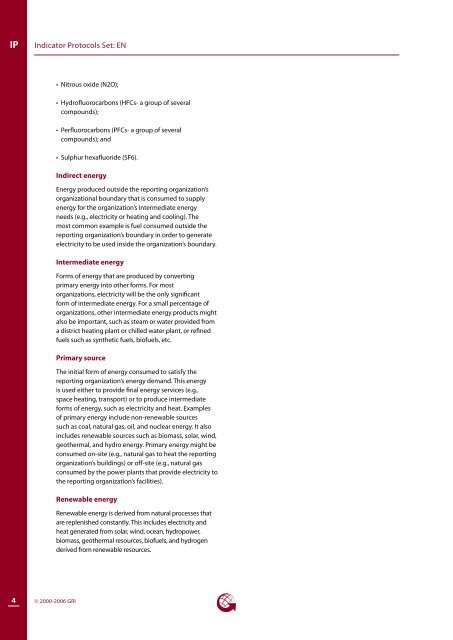Environment - Global Reporting Initiative
Environment - Global Reporting Initiative
Environment - Global Reporting Initiative
Create successful ePaper yourself
Turn your PDF publications into a flip-book with our unique Google optimized e-Paper software.
IP<br />
Indicator Protocols Set: EN<br />
• Nitrous oxide (N2O);<br />
• Hydrofluorocarbons (HFCs- a group of several<br />
compounds);<br />
• Perfluorocarbons (PFCs- a group of several<br />
compounds); and<br />
• Sulphur hexafluoride (SF6).<br />
Indirect energy<br />
Energy produced outside the reporting organization’s<br />
organizational boundary that is consumed to supply<br />
energy for the organization’s intermediate energy<br />
needs (e.g., electricity or heating and cooling). The<br />
most common example is fuel consumed outside the<br />
reporting organization’s boundary in order to generate<br />
electricity to be used inside the organization’s boundary.<br />
Intermediate energy<br />
Forms of energy that are produced by converting<br />
primary energy into other forms. For most<br />
organizations, electricity will be the only significant<br />
form of intermediate energy. For a small percentage of<br />
organizations, other intermediate energy products might<br />
also be important, such as steam or water provided from<br />
a district heating plant or chilled water plant, or refined<br />
fuels such as synthetic fuels, biofuels, etc.<br />
Primary source<br />
The initial form of energy consumed to satisfy the<br />
reporting organization’s energy demand. This energy<br />
is used either to provide final energy services (e.g.,<br />
space heating, transport) or to produce intermediate<br />
forms of energy, such as electricity and heat. Examples<br />
of primary energy include non-renewable sources<br />
such as coal, natural gas, oil, and nuclear energy. It also<br />
includes renewable sources such as biomass, solar, wind,<br />
geothermal, and hydro energy. Primary energy might be<br />
consumed on-site (e.g., natural gas to heat the reporting<br />
organization’s buildings) or off-site (e.g., natural gas<br />
consumed by the power plants that provide electricity to<br />
the reporting organization’s facilities).<br />
Renewable energy<br />
Renewable energy is derived from natural processes that<br />
are replenished constantly. This includes electricity and<br />
heat generated from solar, wind, ocean, hydropower,<br />
biomass, geothermal resources, biofuels, and hydrogen<br />
derived from renewable resources.<br />
4<br />
© 2000-2006 GRI

















